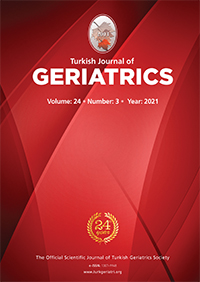2EskiĹźehir Osmangazi University, Department of Physical Medicine and Rehabilitation, EskiĹźehir, Turkey
3EskiĹźehir Osmangazi University, Department of Biostatistics, EskiĹźehir, Turkey DOI : 10.31086/tjgeri.2021.230 Introduction: This study evaluated the effect of coronavirus disease 2019 pandemic on sarcopenia, quality of life and pain severity in elderly patients and investigated which patients were affected more from this pandemic (sarcopenic or not, males or females, and physically active or inactive).
Materials and Methods: A total of 225 elderly patients with SARC-F, visual analogue scale-musculoskeletal pain scores, handgrip strength, chair stand test, short form-36, demographic data and phone number records in July 2020 were included in this study. Follow-up was conducted in June 2021 with telephonic interviews. During follow-up, SARC-F, 10-point Likert pain scale, Short Form-36 and physical activity were evaluated.
Results: After one year of the COVID-19 pandemic, almost all short form- 36 scores decreased; however, the pain and SARC-F scores did not show a significant change. Decrease in short form-36 scores were higher in patients without sarcopenia than in those with sarcopenia. Decrease in Short Form- 36 scores were higher in women than in men. Increase in pain scores (active: p=0.851, inactive: p=0.005) and decrease in Short Form-36 scores, were higher in physically active patients than in physically inactive patients. SARC-F scores did not change in any of the study groups.
Conclusion: After one-year follow-up in elderly patients, quality of life decreased, severity of pain increased in physically inactive, and SARC-F was unaffected. Females, non-sarcopenic, and physically inactive patients were found to be more affected by the COVID-19 pandemic.
Keywords : COVID-19; Pain; Quality of life; Sarcopenia
